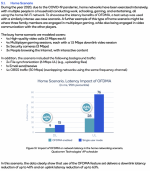sfx2000
Part of the Furniture
11ax testing is many levels more complex that what was done with earlier revisions...
HE frames on the UL are triggered by the AP, and this is done when conditions are suitable ( delta time < 400ns) - if not, the AP shouldn't even try if there is more than 400ns arrival time from the client STA's - frequency stability is also significant in that the delta center freq must be less than 350 Hz (yes, and that ain't much on a 5GHz channel)
Client STA power control is also a thing - as the AP needs to have all the OFDMA RU's arrive at a similar power level, and they have to all arrive in the assigned RU groups, otherwise the RU's, and possibly the entire frame, is lost...
MU-MIMO is also about arrival time, and the I/Q offsets - the AP has no idea of north/south, but it does know about the channel timing, and the sounding reports from the client STA's - and with 11ax - MU links are reciprocal - if conditions are not conducive for DL-MU, it's not likely that UL-MU is going to be any better...
Back in the 4G standards development era - LTE looked at this, as did 802.16m (Mobile Wimax) - LTE decided that the complexity of OFDMA would not have much benefit, and went with a SC-FMDA (also known as LP-OFDMA), which is basically OFMDA with a single RU group...
OFDMA in 802.11ax is an evolution of work done in 802.16m - and we all know how successful that was...
I wouldn't worry too much about OFDMA to be honest... there are other comms tech where there is benefit (DOCSIS 3.1 is a great example), but on WLAN/WWAN, it has not shown results that were promised...


HE frames on the UL are triggered by the AP, and this is done when conditions are suitable ( delta time < 400ns) - if not, the AP shouldn't even try if there is more than 400ns arrival time from the client STA's - frequency stability is also significant in that the delta center freq must be less than 350 Hz (yes, and that ain't much on a 5GHz channel)
Client STA power control is also a thing - as the AP needs to have all the OFDMA RU's arrive at a similar power level, and they have to all arrive in the assigned RU groups, otherwise the RU's, and possibly the entire frame, is lost...
MU-MIMO is also about arrival time, and the I/Q offsets - the AP has no idea of north/south, but it does know about the channel timing, and the sounding reports from the client STA's - and with 11ax - MU links are reciprocal - if conditions are not conducive for DL-MU, it's not likely that UL-MU is going to be any better...
Back in the 4G standards development era - LTE looked at this, as did 802.16m (Mobile Wimax) - LTE decided that the complexity of OFDMA would not have much benefit, and went with a SC-FMDA (also known as LP-OFDMA), which is basically OFMDA with a single RU group...
OFDMA in 802.11ax is an evolution of work done in 802.16m - and we all know how successful that was...
I wouldn't worry too much about OFDMA to be honest... there are other comms tech where there is benefit (DOCSIS 3.1 is a great example), but on WLAN/WWAN, it has not shown results that were promised...


